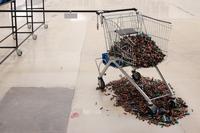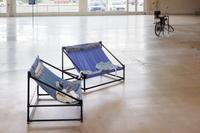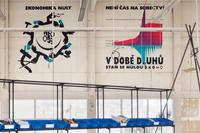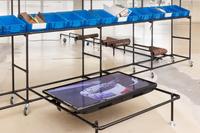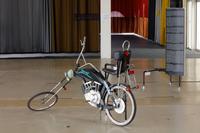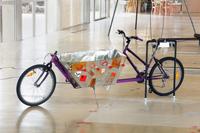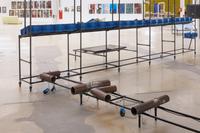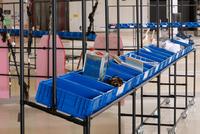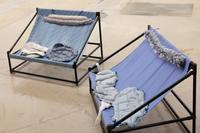Sand in the Gears
PLATO’s central theme for 2020 is “Intensities”. The Sand in the Gears project discusses the essence of intensity as a generally shared characteristic of the contemporary world and examines it by attempting to speed up the process of slowing down.
The experiment starts with the Sand in the Gears exhibition and the accompanying programme: their core is to sabotage productivity and non-growth. Some believe that the self-destructive forces of capitalism, which are innate to it, must be sped up and thus activated; they say it is impossible to slow down now. The present wave of measures intended to counter the pandemic tells us that under certain circumstances it is possible to envisage to slow down and that we are more likely to deal with the tug that follows when the emergency brake is pulled down and with the machine slowing down rather than with a “collision” that occurs at full speed. Can such measures be taken from the top only? Our exhibition aims at drawing the attention to the fact that the sand in the gears, it’s primarily us: us who proudly and intently become the crisis of a machine operating at full capacity.
The core of the exhibition is the “library of materials” and works by artists Hana Drštičková, Andreas Gajdošík, Oto Hudec, Šimon Kadlčák, Marius Konvoj, Vojtěch Kundrát, Apolena Rychlíková, Tereza Vinklárková and Marika Volfová who work with and create from waste materials – remnants of mass production of Ostrava factories and companies. The library of materials is practical and functional; it’s a file cabinet with material samples and users can look at them and explore their touch and feel and other characteristics, both during and after the exhibition because the library of materials will become a permanent fixture of PLATO. We addressed dozens of companies in the Ostrava region to provide us with samples of their waste and scrap materials, information about its composition and the volume of the monthly production. It has been agreed that the materials will be provided for free to those who organise their transport.
The exhibition Sand in the Gears confronts the audience with (art) works made of material samples. These works can inspire the viewer to create his own art and non-art projects – seen as an analogy to a commonplace library of materials displaying producers’ promotional contents and showing their various creative use. However, material and materialism don’t necessarily have to be viewed – as works exhibited prove – as a category related to consumerism; it is also a means of a discursive sabotage of the growth-obsessed society; an environmental communication cord which needs to have not only an idealistic but also a material form.
To use waste and scrap materials and energies is not a self-redemptive solution for artists and art institutions unless they examine their creation and consumption. We want to pick up where Gustav Metzger stopped with his Auto-Destructive Art in the early 1960s. Artworks don’t only have the ambition to destroy themselves but also to destabilise the imperative of art institutions to produce something “joyously new”. Negative recycling and recycling in the context of the Freudian concept of Todestrieb, the death drive, will paradoxically enable us to invest more funds in individuals participating in the project and in their lives. Waste materials in our project aren’t exclusively reserved to artists: they are there for anyone interested. All the artists do is to suggest the possibilities of use of these materials, seen here as “retardants” of growth.
The great challenge awaiting us in the near future is to try and re-evaluate the system based on incessant production and mobility, travelling, dependency on aeroplanes, artist residencies and movement around the globe. The issue is the search for a new and different model: a sustainable and slow one. It’s a matter of patterns and values that we, representatives of the world of art, adhere to, i.e. of everything we consider valuable. In the present-day world, a successful curator or artist is constantly on the move. Movement is considered the imperative factor of success: an artist opens his/her exhibitions on three continents, while a curator is always ready with his/her suitcase packed, moving from one institution to another. In the world of art, this remains the determining position. In our opinion, this attitude should change, and this is why the local focus is so important for our project.
The exhibition opening will be followed by A Heap Made of a Grain of Sand, a four-day retreat (18/6–21/6) open to the public. The retreat, in line with the project, consists of four full-day programmes, a sort of “stops” with a partly planned and partly improvised programme in the presence of artists and professionals participating in its preparation. We hope that this retreat will become a means for integration of our experience with another kind of slowdown forced upon us by the pandemic and the social isolation that has unexpectedly become part of our lives. It influenced the preparation of the Sand in the Gears project, reframed its general message and transformed the personal experience with slowing down of everyone involved. The concept of the exhibition is that of a processual project: some works will be ready for the exhibition opening while others will be made during the retreat and will reflect its course and outputs. The exhibition will keep growing until the beginning of July when it should reach its final shape.
Jakub Adamec and Pavel Sterec
EDIT:
This text was proofread at the turn of March and April, during the state of emergency and quarantine, when the original May date of the exhibition opening was still uncertain. This is when the Sand in the Gears expanded into an unplanned sub-project Sand in the Air, Dune in PLATO curated by Edith Jeřábková. The project aims at connecting and supporting artists facing difficult working conditions. With artists from our vicinity we reflected on what the experience of pandemic brought to our fragile bodies and what this uncertainty meant for our mental health. We addressed artists Jakub Černý, Martin Kubica, Barbora Kurtinová, Otakar Matušek, Šárka Mikesková, Michal Moučka, Filip Nádvorník, Marek Pražák and Hana Puchová. The online project Sand in the Air will be followed, after the gallery’s reopening, by the Dune in PLATO exhibition, which will present a work done together by the artists. Both parts of the project will add another layer to the Sand in the Gears exhibition.
Václav Drozd – political scientist, journalist and union organiser
Hana Drštičková – student of art and anthropology
Jakub Černý – psychologist, social worker and therapist
Andreas Gajdošík – visual artist and programmer
Oto Hudec (SK) – visual artist
Šimon Kadlčák – visual artist, publicist and curator
Marius Konvoj – audio-visual artist
Vojtěch Kundrát – chemist and visual artist
Tomasz Rakowski (PL) – ethnologist, cultural anthropologist and doctor
Eva Rossal (PL) – cultural anthropologist, scientist and curator
Apolena Rychlíková – documentary filmmaker, publicist and journalist
Tereza Vinklárková – visual artist
Marika Volfová – visual artist
Curators/coordinators:
Jakub Adamec – PLATO dramaturge and curator, audio-visual artist
Pavel Sterec – visual artist and teacher at the Faculty of Fine Arts at Brno University of Technology
Václav Drozd is a political scientist, journalist, and union organiser. He graduated in Political Science at the Charles University in Prague. Between 2016 and 2019 he worked as an editor in the online daily A2larm. He works as a union organiser in Central European Organising Center and helps employees of multinationals improve their working conditions. He is also active in the movement for climatic justice. He lives in Prague.
Hana Drštičková is a student of art and anthropology. She oscillates between her studies of social anthropology at the Faculty of Social Studies at Masaryk University in Brno and the Intermedia Studio at the Faculty of Fine Arts at the Brno University of Technology. In the field of art and anthropology, she is interested in psychological health and alienation and in opportunities to establish a relationship with the environment in contemporary society. In her work, Hana uses video, performance and text. She lives in Brno.
Jakub Černý is a psychologist, social worker and therapist. He worked in the field of drug use, dependencies, and mental health. As a supervisor, lecturer and activist he supports projects related to social change and emancipation of people with personal experience with the above mentioned, e.g. in the Street Support project. Černý is one of the founding members of Narativ, an association dedicated to the development of collaborative and dialogue-led practice in the Czech Republic, to structural and political aspects of mental health and the related support system. He is active in Ostrava and Brno.
Andreas Gajdošík is a visual artist and programmer, a graduate of the Intermedia Studio at the Faculty of Fine Arts at the Brno University of Technology. In his art practice, Gajdošík intervenes in media and social networks and creates mystification software and websites to create a space for critical reflection on established structures of the art world as well as the political space and its extreme positions. He is a 2019 Jindřich Chalupecký Award laureate. He lives in Brno.
Oto Hudec is a visual artist. He uses various media to reflect on the issue of immigration, voluntary isolation, and possible or impossible utopia. Lately, Hudec has dedicated himself to the issue of climatic crisis: both in his art practice and the initiative Neztrácejme čas (Let’s Not Lose Time). In his projects, Hudec often uses utopia as a method of pointing at contradictions and inequalities in a seemingly logically functioning society. He is a finalist of the 2012 Oskar Čepan Award. He lives in Košice.
Šimon Kadlčák is a visual artist, opinion journalist (Artalk, A2, Fotograf), curator, and a graduate of the Intermedia Studio at the Faculty of Fine Arts at the Brno University of Technology. In his art practice, he currently explores the theme of dissolving identity of an individual in a group, or under the influence of altered states of consciousness. Kadlčák is a co-founder of the experimental off-space Zaazrak|Dornych in Brno and participates in ArtMap; he is the co-author of the Atlas of Spontaneous Art which maps artworks in public space in the Czech Republic by self-taught artists. He lives in Brno.
Marius Konvoj is an audio-visual artist, a graduate of the Intermedia Studio at the Faculty of Fine Arts at the University of Ostrava. He is the author of Instagram project Neoego Act. He is active in the field of environmental, social and emotional debts made by previous generations but to be paid by the future generation. Konvoj uses the language of social media, advertising and rubbish phenomena of visual communication. He is a half of the audio-visual duo I Love 69 Popgejů. He lives in Ostrava.
Vojtěch Kundrát is a chemist and visual artist, a PhD student at the Faculty of Chemistry at the Brno University of Technology and a student in the Intermedia Studio at the Faculty of Fine Arts at the Brno University of Technology. He focuses on development aid and development of affordable technologies for water purification without electricity. He is the co-author of sunscreen for the disadvantaged albino population in western Africa. He enthusiastically discovers the world of art and how it blends into other areas of human activity, including chemistry and industrial technologies. He lives in Brno.
Tomasz Rakowski is an ethnologist and cultural anthropologist, an Associate Professor at the Institute of Ethnology and Cultural Anthropology, University of Warsaw, and also a medical doctor with speciality in A&E medicine. His research interests include social art, phenomenological anthropology, post-socialist transformation, anthropology of poverty and anthropology of development. Rakowski led ethnographic field research in Poland and Mongolia. He lives in Warsaw.
Eva Rossal is a cultural anthropologist, scientist and curator. She works in the Ethnographic Museum in Krakow and collaborates with the Institute of Ethnographic and Cultural Anthropology at the Jagiellonian University in Krakow. Rossal focuses on experimental collaboration between socially engaged, participative, useful art and anthropology, anthropology of fashion and clothing, a new methodology of ethnographic research and usefulness of anthropology beyond the academia. She led field research in Poland and Italy. She lives in Krakow.
Apolena Rychlíková is a document filmmaker, opinion journalist and journalist. In her work, she deals with the issues of inequalities, social exclusion, feminism, ecology and affordable housing. She is an in-house editor of the A2larm.cz server, a commentator for Salon (Právo daily) and external commentator for Czech Radio Plus. Her documentary film Hranice práce (The Limits of Work) won the 2017 Best Czech Documentary Film Award at the International Festival of Documentary Films Ji.hlava and the Czech Film Critics Award. She lives in Prague.
Tereza Vinklárková is a visual artist who also works under her pseudonym Gloriya Komarova. She studies at the Intermedia Studio at the Faculty of Fine Arts at the Brno University of Technology. In her art practice, she explores the selfie culture and uses it alongside social platforms to describe social and global transformations. At present, she experiments with DIY aesthetics and with the creation of a safe space environment which gradually becomes an inherent part of art projects. She lives in Brno.
Marika Volfová is a visual artist and PhD student at the Faculty of Fine Arts at the Brno University of Technology. She focuses on the research of visual strategies of environmental movements and is also an activist from the Limity jsme my (Limits Are Us) movement. She lives in Brno.
Curators/coordinators:
Jakub Adamec is PLATO dramaturge and curator, member of the audio-visual group I Love 69 Popgejů. He worked for the Czech Centre in Warsaw (Poland), Třinec Municipal Gallery and in Ostrava gallery Strážná věž (Watch Tower). Adamec is graduate of the Intermedia Studio of the Institute of Fine Arts Studies at the University of Ostrava. He lives in Ostrava.
Pavel Sterec is a visual artist and teacher. A graduate from the Academy of Arts and AAAD in Prague, Sterec teaches at the Faculty of Fine Arts at the Brno University of Technology. He is interested in non-scientific research, interdisciplinarity, radical pedagogy, methods of unlearning, and user-oriented art. He lives in Prague.
–
- –Seminar:Moments of collective pleasure in the time of the industry of happiness (part 2)Seminar about possible responses to fatigue, dissatisfaction and spleen in the culture of individuation and acceleration.
- –Workshop for families:The Best Possible Screenplay / An Imaginative Warm-UpSunday workshop for parents with children with artist Monika Volfová and sociologist Mikuláš Černík.
–
- –Performance reading:I Love 69 Popgejů / Josef Váchal: Sermon ad calendas graecas against the sin of hastePerformance reading
- –Lecture:Moments of collective pleasure in the time of the industry of happiness (part 1)Lecture and discussion about possible responses to fatigue, dissatisfaction and spleen in the culture of individuation and acceleration.
- –Friday Cinema with Discussion:Apolena Rychlíková: Manifest jiné práce (2016) and Biologicky předurčené k chudobě (2018)Film screening and discussion.
- –Workshop:Václav Drozd: On manager’s solar plexusWorkshop about union organising for employees of (cultural) institutions.
- –Workshope and lecture:Eva Rossal: Creative ethnography – assumptions, ideas, processesWorkshop and lecture on research making use of contemporary art, cultural animation and ethnography.
- –Lecture:Tomasz Rakowski: Shared space, individual space – art, ethnography and every dayLecture for those interested in the dialogue between artistic and ethnographic-anthropological method.
- –Discussion:Recycling behind the rainbow of binsDiscussion with representatives of dumpster diving [searching bins and taking foodstuff and things found in them] from Food Not Bombs organization, Ostrava City Hall, OZO Ostrava company and digital waste market Cyrkl.
- –Lecture:Vojtěch Kundrát: Mass for nothingLecture on the chemistry of materials beyond the borders of industrial use.
- –Workshop:Pavel Sterec: The art of non-growthWorkshop for high school students.
←→
Special thanks to the Ministry of Culture of the Czech Republic and Moravian-Silesian Region.





